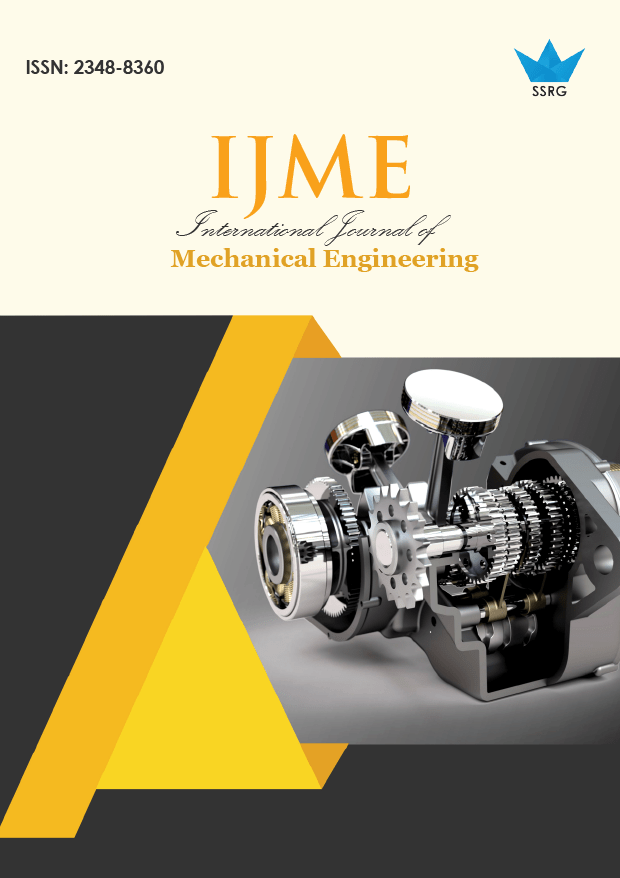A Numerical Investigation of the Effect of Stenosed Trapezoidal Shape Models on Sinusoidal Pulsatile Hemodynamics for Arterial Blood Flow

| International Journal of Mechanical Engineering |
| © 2025 by SSRG - IJME Journal |
| Volume 12 Issue 10 |
| Year of Publication : 2025 |
| Authors : Md. Jashim Uddin |
How to Cite?
Md. Jashim Uddin, "A Numerical Investigation of the Effect of Stenosed Trapezoidal Shape Models on Sinusoidal Pulsatile Hemodynamics for Arterial Blood Flow," SSRG International Journal of Mechanical Engineering, vol. 12, no. 10, pp. 60-78, 2025. Crossref, https://doi.org/10.14445/23488360/IJME-V12I10P106
Abstract:
Numerical computations of the flow pulsation in a stenotic vessel are employed to examine the various trapezoidal stenosis shapes’ impact on the flow characteristics around the stenotic and post-stenotic zones. The finite element method-based COMSOL Multiphysics software is adopted with a satisfactory verification of the numerical technique. The findings show that both Wall Shear Stress (WSS) and wall pressure rise with higher flow rates and larger sizes of stenosis. Womersley numbers (Wo) significantly dominate the wall pressure, but there are no considerable effects on the peak WSS. The wall pressure profile is shown to be more influenced by the shape of mild contraction than the moderate contraction and right-angle expansion shape (model III). It is also transpired that the WSS of the shape of mild contraction is larger than that of the shape of moderate contraction and right-angle expansion (model III) around the blockage area, and model III shows the greater recirculation length downstream of stenosis. The relative residence time in correspondence with the oscillatory shear index’s second peak at the locations of flow recirculation shows the more disturbed flow patterns for model III. Therefore, patients with different models of stenosis will significantly affect atherosclerotic hemodynamics.
Keywords:
Computational Fluid Dynamics, Womersley number, Hemodynamic risk factors, Recirculation length, Hemodynamics.
References:
[1] V. Deplano, and M. Siouffi, “Experimental and Numerical Study of Pulsatile Flows through Stenosis: Wall Shear Stress Analysis,” Journal of Biomechanics, vol. 32, no. 10, pp. 1081-1090, 1999.
[CrossRef] [Google Scholar] [Publisher Link]
[2] Centers for Disease Control and Prevention, National Center for Chronic Disease Prevention and Health Promotion (NCCDPHP) [Online]. Available: https://www.cdc.gov/nccdphp/index.html
[3] John M. Tarbell, “Mass Transport in Arteries and the Localization of Atherosclerosis,” Annual Review of Biomedical Engineering, vol. 5, pp. 79-118, 2003.
[CrossRef] [Google Scholar] [Publisher Link]
[4] Saad A. Ahmed, and Don P. Giddens, “Velocity Measurements in Steady Flow through Axisymmetric Stenoses at Moderate Reynolds Numbers,” Journal of Biomechanics, vol. 16, no. 7, pp. 505-507-509-516, 1983.
[CrossRef] [Google Scholar] [Publisher Link]
[5] Noureddine Kaid et al., “Unveiling Hemodynamic Pulsatile Flow Dynamics in Carotid Artery Stenosis: Insights from Computational Fluid Dynamics,” AIP Advances, vol. 14, no. 6, pp. 1-13, 2024.
[CrossRef] [Google Scholar] [Publisher Link]
[6] Matadial Ojha et al., “Pulsatile Flow through Constricted Tubes: An Experimental Investigation using Photochromic Tracer Methods,” Journal of Fluid Mechanics, vol. 203, pp. 173-197, 1989.
[CrossRef] [Google Scholar] [Publisher Link]
[7] Moloy Kumar Banerjee, Ranjan Ganguly, and Amitava Datta, “Effect of Pulsatile Flow Waveform and Womersley Number on the Flow in Stenosed Arterial Geometry,” International Scholarly Research Notices, vol. 2012, no. 1, pp. 1-12, 2012.
[CrossRef] [Google Scholar] [Publisher Link]
[8] M.D. Deshpande, D.P. Giddens, and R.F. Mabon, “Steady Laminar Flow through Modelled Vascular Stenoses,” Journal of Biomechanicss, vol. 9, no. 4, pp. 165-174, 1976.
[CrossRef] [Google Scholar] [Publisher Link]
[9] M. Saqib Hameed et al., “Comparison of Blood Flow Analysis in Stenosed and Stented Carotid Artery Bifurcation Models,” Cogent Engineering, vol. 10, no. 1, pp. 1-20, 2023.
[CrossRef] [Google Scholar] [Publisher Link]
[10] M. Wootton David, and N. Ku David, “Fluid Mechanics of Vascular Systems, Diseases, and Thrombosis,” Annual Review of Biomedical Engineering, vol. 1, pp. 299-329, 1999.
[CrossRef] [Google Scholar] [Publisher Link]
[11] Robert M. Nerem, “Hemodynamics and the Vascular Endothelium,” Journal of Biomechanical Engineering, vol. 115, no. 4B, pp. 510-514, 1993.
[CrossRef] [Google Scholar] [Publisher Link]
[12] J.J. Chiu et al., “Effects of Disturbed Flow on Endothelial Cells,” Journal of Biomechanical Engineering, vol. 120, no. 1, pp. 2-8, 1998.
[CrossRef] [Google Scholar] [Publisher Link]
[13] Feng Wang et al., “Linear Surrogate Modelling for Predicting Hemodynamic in Carotid Artery Stenosis During Exercise Conditions,” Chinese Journal of Physics, vol. 94, pp. 262-273, 2025.
[CrossRef] [Google Scholar] [Publisher Link]
[14] Edith E. Alagbe et al., “Computational Simulation of Atherosclerosis Progression Associated with Blood Pressure in a 2-D Idealized Human Carotid Artery Model,” The Open Chemical Engineering Journal, vol. 16, pp. 1-10, 2022.
[CrossRef] [Google Scholar] [Publisher Link]
[15] S.J. Sherwin, and H.M. Blackburn, “Three-Dimensional Instabilities and Transition of Steady and Pulsatile Axisymmetric Stenotic Flows,” Journal of Fluid Mechanics, vol. 533, pp. 297-327, 2005.
[CrossRef] [Google Scholar] [Publisher Link]
[16] Byoung Jin Jeon et al., “A Numerical Study on the Effect of Trapezium Stenosis Shape on the Axisymmetric flow Field around Stenosis,” Journal of Mechanical Science and Technology, vol. 32, pp. 2651-2658, 2018.
[CrossRef] [Google Scholar] [Publisher Link]
[17] Maria Vittoria Caruso et al., “Computational Analysis of Stenosis Geometry Effects on Right Coronary Hemodynamics,” 2015 37th Annual International Conference of the IEEE Engineering in Medicine and Biology Society (EMBC), Milan, Italy, pp. 981-984, 2015.
[CrossRef] [Google Scholar] [Publisher Link]
[18] Wei Liao, T.S. Lee, and H.T. Low, “Numerical Studies of Physiological Pulsatile Flow through Constricted Tube,” International Journal of Numerical Methods for Heat & Fluid Flow, vol. 14, no. 5, pp. 689-713, 2004.
[CrossRef] [Google Scholar] [Publisher Link]
[19] A.B.M. Toufique Hasan, and D. Kanti Das, “Numerical Simulation of Sinusoidal Fluctuated Pulsatile Laminar Flow through Stenotic Artery,” Journal of Applied Fluid Mechanics, vol. 1, no. 2, pp. 25-35, 2012.
[CrossRef] [Google Scholar] [Publisher Link]
[20] T. Ray Mahapatra, G.C. Layek, and M.K. Maiti, “Unsteady Laminar Separated Flow through Constricted Channel,” International Journal of Nonlinear Mechanics, vol. 37, no. 2, pp. 171-186, 2002.
[CrossRef] [Google Scholar] [Publisher Link]
[21] G.R. Zendehbudi, and M.S. Moayeri, “Comparison of Physiological and Simple Pulsatile Flows through Stenosed Arteries,” Journal of Biomechanics, vol. 32, no. 9, pp. 959-965, 1999.
[CrossRef] [Google Scholar] [Publisher Link]
[22] Temiloluwa Amoo, Osejie Oriaifo, and Augustine Ayeni, “Computational Simulation of the Effects of Blood Flow Velocity on Atherosclerosis Progression in a Human Carotid Artery,” F1000 Research, vol. 13, pp. 1-17, 2024.
[CrossRef] [Google Scholar] [Publisher Link]
[23] S.A. Berger, and L.D. Jou, “Flows in Stenotic Vessels,” Annual Review in Fluid Mechanics, vol. 32, pp. 347-382, 2000.
[CrossRef] [Google Scholar] [Publisher Link]
[24] R. Mittal, S.P. Simmons, and H.S. Udaykumar, “Application of Large-Eddy Simulation to the Study of Pulsatile Flow in a Modeled Arterial Stenosis,” Journal of Biomechanical Engineering Transactions ASME, vol. 123, no. 4, pp. 325-332, 2001. [CrossRef] [Google Scholar] [Publisher Link]
[25] J. Satya Eswari et al., “Prediction of Stenosis Behaviour in Artery by Neural Network and Multiple Linear Regressions,” Biomechanics and Modeling in Mechanobiology, vol. 19, pp. 1697-1711, 2020.
[CrossRef] [Google Scholar] [Publisher Link]
[26] Mahesh C. Udupa, Sunanda Saha, and Sekarapandian Natarajan, “Study of Blood Flow Patterns in a Stenosed Artery through the Combined Effect of Body Acceleration and Generalized Womersley Solution,” Scientific Reports, vol. 15, pp. 1-18, 2025.
[CrossRef] [Google Scholar] [Publisher Link]
[27] Stefania Espa, Monica Moroni, and Maria Antonietta Boniforti, “In-Vitro Simulation of the Blood Flow in an Axisymmetric Abdominal Aortic Aneurysm,” Applied Sciences, vol. 9, no. 21, pp. 1-16, 2019.
[CrossRef] [Google Scholar] [Publisher Link]
[28] R. Padma, R. Tamil Selvi, and R. Ponalagusamy, “Effects of Slip and Magnetic Field on the Pulsatile Flow of a Jeffrey Fluid with Magnetic Nanoparticles in a Stenosed Artery,” The European Physical Journal Plus, vol. 134, 2019.
[CrossRef] [Google Scholar] [Publisher Link]
[29] S. Kang, H.G. Choi, and J.Y. Yoo, “Investigation of Fluid–Structure Interactions using a Velocity-Linked P2/P1 Finite Element Method and the Generalized- α Method,” International Journal for Numerical Methods in Engineering, vol. 90, no. 12, pp. 1529-1548, 2012.
[CrossRef] [Google Scholar] [Publisher Link]
[30] D. Gallo et al. “On the Use of In Vivo Measured Flow Rates as Boundary Conditions for Image-Based Hemodynamic Models of the Human Aorta: Implications for Indicators of Abnormal Flow,” Annals of Biomedical Engineering, vol. 40, pp. 729-741, 2012.
[CrossRef] [Google Scholar] [Publisher Link]
[31] Qinghai Huang et al., “Hemodynamic Changes by Flow Diverters in Rabbit Aneurysm Models,” Stroke, vol. 44, no. 7, pp. 1936-1941, 2013.
[CrossRef] [Google Scholar] [Publisher Link]
[32] Panagiotis Kelidis, and Efstathios Konstantinidis, “Pulsatile Flow through a Constricted Tube: Effect of Stenosis Morphology on Hemodynamic Parameters,” Computer Methods in Biomechanics and Biomedical Engineering, vol. 21, no. 7, pp. 479-487, 2018.
[CrossRef] [Google Scholar] [Publisher Link]
[33] Johannes V. Soulis et al., “Relative Residence Time and Oscillatory Shear Index of Non-Newtonian Flow Models in Aorta,” 2011 10th International Workshop on Biomedical Engineering, Kos, Greece, pp. 1-4, 2011.
[CrossRef] [Google Scholar] [Publisher Link]

 10.14445/23488360/IJME-V12I10P106
10.14445/23488360/IJME-V12I10P106